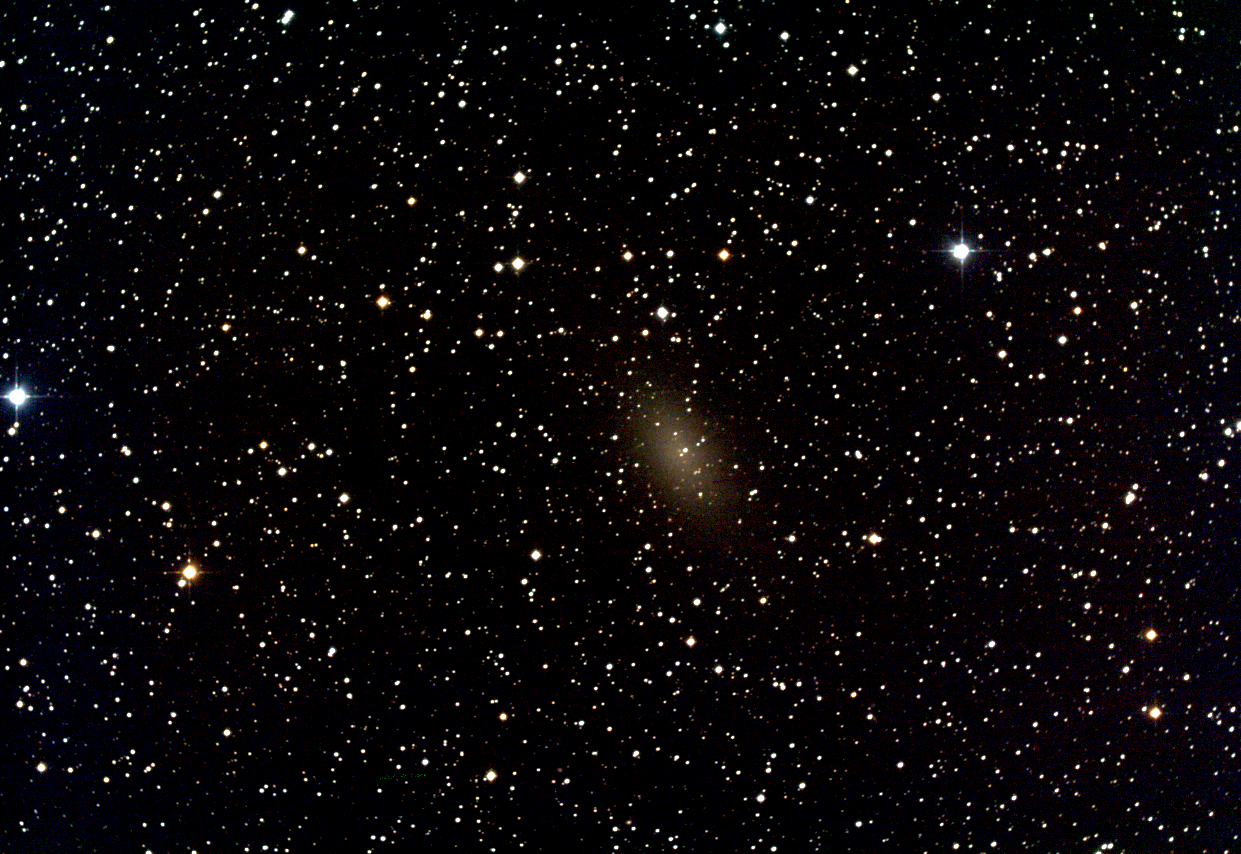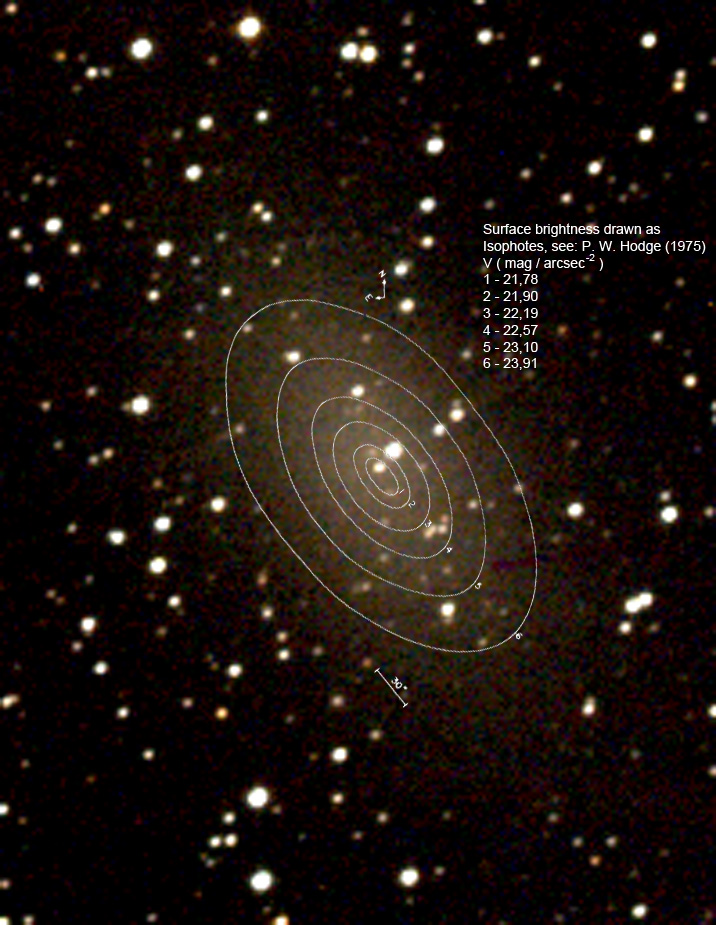W. Baade (1944) found the dwarf galaxy NGC 147 a companion to the famous Andromeda galaxy, which was numbered by Charles Messier as catalog Nr. 31 (Messier 31, NGC 224). However, contrast could hardly be starker when comparing both galaxies. Certainly, Messier 31 is the brightest galaxy seen from the northern hemisphere. In a clear dark night, Messier 31 can be seen with the naked eye or using small binoculars. NGC 147 is an elliptical dwarf galaxy with a total magnitude of 10 Vmag. NGC 147 never will be detected with the naked eye and hardly will be detected from short-exposure images of a mid-range amateur telescope. Why is a 10th magnitude galaxy, like NGC 147 so hard to detect?
Figure 1: Field around the nearby dwarf galaxy from a 4 hours exposure. Click to enlarge.
The reason why NGC 147 appears that faint is its extraordinary low surface brightness. The galaxy spans an area of around 14x8 arcminute at the sky. The stellar content is sparse. A handful of globular clusters have been identified and the brightest stars are found at 22 Vmag (Yang & Sarajedini, 2010). The dimension of NGC 147 is very similar to many other well-known deep-sky objects. But, illumination values found for common bright deep-sky object sometimes will cheat. The average surface brightness of NGC 147 can be computed from its total brightness divided by the area it spans. Using the total brightness of 10 Vmag, an average value of 23 Vmag per square arcsec is computed. This is much less than the sky level detected with a typical observing site. Expressed in numbers the sky brightness at a typical suburban amateur site is given with 19 Vmag arcsec-2. The illumination level of the galaxy is 4 magnitudes smaller than the black sky portion. This is 1/40 or 2.5 percent of the sky illumination level. Quite a challenge even for the experienced astrophotographer! Hodge (1976) measured surface brightness of NGC 147 and gave us an impression how the surface brighness drops from the center of the galaxy to the outer regions. The plotted isophotes, portions of nearly the same brightness are drawn in his work. In fact the surface brightness drops from around 21 Vmag arcsec-2 to nearly 24 Vmag arcsec-2 towards the outer regions of the dwarf galaxy NGC 147.
Figure 2: NGC 147 superimposed with isophotes presented by Hodge (1976). North is up.
| Isophote Nr. | Vmag arcsec-2 |
| 1 | 21.78 |
| 2 | 21.90 |
| 3 | 22.19 |
| 4 | 22.57 |
| 5 | 23.10 |
| 6 | 23.91 |
Table: Isophotes and their corresponding magnitudes derived by Hodge (1976).
The detection level and limiting magnitude with this 4 hours exposure of NGC 147 is found below 24 Vmag arcsec-2. Therefore it should be possible to detect single stars with NGC 147. The single stars found with the image are foreground stars and a handful of globular clusters. These stars at 22 Vmag are not clearly detected with the image, however. What is the reason for this?
Looking closer to the faint background stars, the area where the light of a star is spread typically spans 5x5 pixel in the original image. This means, the light of a star is distributed over a certain area of several pixel. Therefore, a degradation of the detection level of point light sources is introduced by seeing. The loss of peak illumination level is typically a factor of up to 10 or more, which corresponds to more than 2 stellar magnitudes. This depends on the detector pixel dimension and seeing disk diameter. To give an example: A seeing disk diameter of 3 arcsec full width half maximum detected by a detector with pixel dimension of 1.2 arcsec might produce a maximum peak intensity of a star which is only 16 percent or less of the peak intensity, as if the star were recorded into one single pixel. According to Pogson's law 16 percent (%) of the original peak intensity corresponds to a loss of the detection limit by 2 stellar magnitudes! Now it is clear, that it is much more difficult to measure a light curve of a variable star from a distant galaxy like NGC 147. Even if the sparse stellar content would enable us to observe single stars from that galaxy.
The work of Hodge (1976) tells us a bit more about the whole story behind the scenes: A limiting magnitude of 24 Vmag was a record setting mark even for the giant 5m class telescopes in the 70ies of the 20th century. Impressive enough to see, a small 8 inch (20 cm) amateur telescope can perform this as well using even a simple DSLR camera!
Three major drawbacks of the method presented are: (1) the spectral response of the detector, (2) the non-linearites of a photographic plate, and (3) the comparison of a surface brightness with a limiting magnitude of a star. The spectral response of a photographic plate is broader than the filter transmission of a certain electronic device and filter. Thus, magnitudes are hard to compare. The behaviour of a photographic plate is very different from electronic devices, that are used by the modern astonomer. Photographic plates suffer from non-linearities especially at the borders of the range of susceptibility. These are the detection level at low illumination and, at the upper end of the scale, the level of saturation. This makes it hard to get certainty at the lower bounds of the scale, here the detection level of low illumination. Therefore, the limiting magnitude extracted from the work of Hodge must be taken with care. There are too many effects influencing a correct calibration, like the Schwarzschild effect of increasing non-linearities with very long exposures. A further drawback is the inability to compare a surface brightness given in units of [mag arcsec-2] with the limiting magnitude of a star given in [mag]. The detection level of a star certainly can be more than a factor 10 above the detection limit of an extended surface brightness. This, because the star falls onto several pixels and the low illumination again is distributed across several pixel. In other words, it is harder to detect a single star, than to detect a surface illumination.
Conclusion
A total magnitude of 10 Vmag seems detectable with a mid-range amateur telescope. However, due to the relatively large dimension the galaxy is hard to detect even from long exposures. The outer regions of this dwarf galaxy NGC 147 show very low illumination levels. The surface brightness drops from 21 Vmag arcsec-2 at the center to a value below 24 Vmag arcsec-2 in the outer regions of NGC 147. Therefore NGC 147 is a typical test case for any amateur equipment. Light curves from variable stars would enable the estimation of the distance modulus of the galaxy. However, and due to the seeing effects, the limiting magnitude of point light sources may be found factors above the limiting magnitude of the surface brightness of the dwarf galaxy. A star typically is spread over a region which is more than 1 arcsec-2. Therefore, the detection limit expressed in magnitudes, either visual, photographic or any other wavelength, always denotes the detection limit of a surface illumintation. The detection limit of stars is not comparable to this limit found with an extended light source, like the dwarf galaxy NGC 147. To be able to resolve the bright stars contained with that galaxy, better seeing is needed. A finer sampling grid and smaller images of the stars are required to obtain a better contrast. Typically this is done with a larger telescope and active optics. Alternatively, a technique could be applied to sharpen the image, which might be a super resolution method.
Literature
Baade, W., 1944. NGC 147 and NGC 185, Two New Members of the Local Group of Galaxies. Astrophysical Journal, vol. 100, p.147
Hodge, P. W., 1976. The structure of NGC 147. Astron. J., Vol. 81, p. 25 - 29, 87
Yang, S.-C. and Sarajedini, A., 2010. RR Lyrae Variables in the Local Group Dwarf Galaxy NGC 147. The Astrophysical Journal, vol. 708, 1, pp. 293-303
Observational data
| Telescope: | Vixen VC200L, focal reducer f/6.4, Sphinx SXD |
| Camera: | Canon EOS 60D, clear glass modification (internal filter removed), 400 ASA |
| Filter: | Astronomik UV/IR EOS block filter |
| Exposure: | 480 x 30s, total 4 hours |
| Calibration: | Dark (780 images), Sky-Flat (50 images) |
| Image Processing: | Shift & add with correction of subpixel movement, improved noise reduction |
| Date of exposure: | 03 October 2011, 19:38 h - 00:36 h MEZ |
| Software: | ArgusPro SE |
| Remark: | Limiting magnitude detected at 24 Vmag arcsec-2 |


